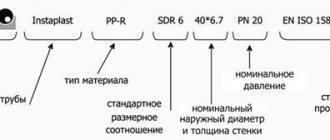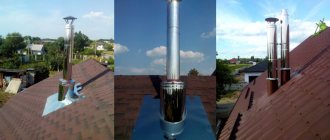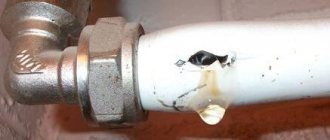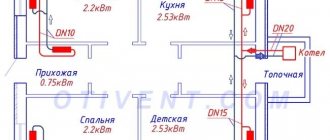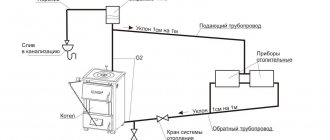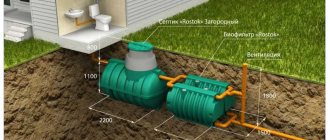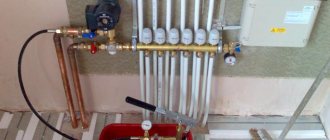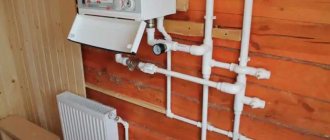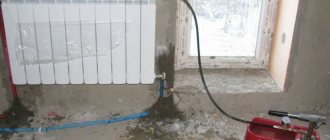Advantages and disadvantages of a water heating system
The main disadvantage of water heating in a private home is the need to purchase a large number of different materials. Namely: pipes, shut-off valves, fittings, radiators, boiler and circulation pump. The latter is not used in all systems.
And other shortcomings that can be described as nonsense if the owner of the house is indifferent to his home:
- Water leaks during operation. Today this situation is rare because plastic pipes have been replaced by plastic pipes. But even they sometimes leak at the junctions with other materials. These are already claims against the installation manufacturer.
- The water inside the system may freeze if it is not drained for the winter. This situation is for houses that are not used during the cold season.
Plastic pipes have solved many problems
Water heating has more advantages, which is why the majority of developers of new houses choose it:
- uniform distribution of heat throughout all rooms;
- installing one heating boiler makes it possible to control the process from one place;
- all equipment, except radiators, and piping can be made hidden. That is, organize a boiler room in the office space, and hide the pipes in grooves on the walls or in the floor. Using a heated floor system generally solves the problem of hidden installation. Even the radiators will not be visible;
- The coolant temperature does not exceed +95°C. And the surface of the batteries heats up to +65°C. You can’t get burned on them; dust doesn’t burn on them;
- water heating produces soft heat.
Heating system with hidden pipe wiring
Selection of material for the pipeline
Polypropylene pipes.
Polypropylene is considered to be the most optimal material for pipeline construction. Compared to analogues, it is distinguished by reliability and durability, as well as ease of installation. Polypropylene blanks are connected by welding, which allows you to install pipes in the wall and under the floor covering.
Attention! The cost of polypropylene and fittings for them when used as a pipeline will be much lower than, for example, the cost of pipes and components made of metal-plastic.
Features of a water heating system
From the name itself it becomes clear that the coolant in this case is water. This is the environment that accumulates thermal energy well and releases it easily. It has a high heat capacity, expands when heated, but contracts poorly when pressure increases. Water density is 950 kg/m³. The principle of operation of water heating is quite simple. The water is heated in the boiler, and then moves through pipes to the radiators, where it gives off its heat, and returns through the return circuit to the boiler.
How the coolant moves through the heating system
The main task of the heating assembly is to force the coolant to move along the circuit. Therefore, there are two types of heating systems: with natural circulation of coolant and with forced circulation. In the first case, water moves through the pipes under the influence of physical laws, when the warm medium rises up and the cold medium goes down. In the second, movement occurs due to the operation of the circulation pump. But more on that below, and now let’s look at what materials and equipment are best to choose for installing water heating.
One- or two-pipe heating
Single pipe system
This design of the heating system is made in the form of a closed ring with heating devices connected in series. As the coolant passes through the radiators, it gives off heat and moves further until it reaches the last of them. After which the liquid is returned to the boiler. This system is used for heating buildings with an area of no more than 100 sq.m.
Single pipe system
The cost of installing a single-pipe heating system is not high and is not complicated. It does not require a large amount of materials to create it.
The serial connection of heating devices leads to the stoppage of the entire system if one of its elements fails. The large length of the pipeline leads to significant heat losses. To regulate the heat transfer of radiators, the purchase and installation of additional thermostats is required.
Two-pipe system
This heating scheme can be used to heat houses with different areas and number of floors. It consists of two pipeline lines. One of them serves to supply coolant to heating devices, and the other to drain liquid from them.
Two-pipe system
This design has a number of advantages compared to a single-pipe system. In this case, it is possible to regulate the supply of coolant to each radiator individually, which allows you to create a uniform temperature regime in the rooms. It is also possible to install modern radiators. A breakdown in one section of the structure does not stop the operation of the entire system.
The cost of constructing a two-pipe heating system in a country house increases significantly. This is due to increased labor intensity of installation and a greater need for materials. However, despite the increase in the length of the pipes, this disadvantage is compensated by a decrease in their diameter, which reduces costs.
Basic elements of water heating
The water heating system includes:
- heat generator, also known as a boiler or furnace;
- pipes;
- radiators;
- circulation pump;
- expansion tank.
Complete set: boiler, radiators, pump and expansion tank
Heating boilers
Before purchasing and installing a heating boiler in a private home, you need to calculate its power. This indicator reflects the amount of thermal energy supplied. And the larger the area of a private house, the more powerful the equipment must be installed.
Gas generator for heating a private house
It is easy to calculate the power of the unit. To do this, you need to know one ratio - for 10 m² you need 1 kW of thermal energy. This takes into account that the height of the ceilings in the rooms is no more than 3 m. But it is necessary to understand that this ratio will act differently in different climatic regions. Therefore, SNiPs contain climate coefficients.
| Region | Northern | Middle lane | Southern |
| Coefficient | 1,5-2,0 | 1,0-1,2 | 0,7-0,9 |
For example, the total area of a private house located in Murmansk is 100 m². The boiler power is determined as follows:
- 100 / 10 = 10 kW;
- 10 x 2 = 20 kW , where “2” is the northern coefficient.
Liquid fuel boiler assembly
Now, regarding the classification. Heating units are mainly divided according to the type of fuel used: gas, electric, solid or liquid fuel. If gas is installed in the house, then this is the best option. All other types are considered taking into account what is beneficial. If the power supply is inconsistent or the network voltage is weak, then it is better to give preference to solid fuel boilers. By the way, the latter are not only wood-burning structures, they are modern pellet options, which have wider functionality and higher efficiency.
Solid fuel wood boiler in operation
Attention! Purchasing a boiler is not cheap, so fireplaces and kitchen stoves in which a heat exchanger is installed can be used as heating generators.
Electric heating boiler
Related article:
Long-burning wood-fired boilers for the home. From this publication you will learn everything about wood-burning boilers, their types and nuances of use.
Pipes
Everything is simple here - you only need to use the plastic version. Pay attention to its temperature limit for use. Because there are pipes for cold water and for hot water. In heating, the second position is used.
Plastic pipes for heating
You can talk about the diameter of the pipes only after a full calculation of the system. But first we can say that material with a diameter of less than 40 mm cannot be used for the supply and return circuits. Radiator connections are products with a diameter of 20-25 mm.
Related article:
Heating pipes: which ones are better. Varieties of products, their advantages and disadvantages, how to choose the right diameter, how to insulate - you will find all this and much more in our publication.
Radiators for heating
Manufacturers today offer four types of heating batteries:
- cast iron,
- steel (tubular or panel),
- aluminum,
- bimetallic (steel pipes inside, aluminum on top).
Cast iron radiator - accordion
Related article:
What heating radiators are best to install in an apartment. In this review we will look at the types of radiators, their advantages and disadvantages, popular models and manufacturers.
Each type has its own pros and cons. For example, cast iron heats up slowly, but retains heat for a long time. Aluminum heats up quickly, gives off the most thermal energy, but quickly corrodes. In this regard, the best option is bimetallic or steel, as the golden mean.
Steel tubular radiator
It is important to calculate the required number of battery sections, because this value determines how much heat will be released into the rooms of the house. It is not difficult to do the calculation yourself. To do this, you need to know the area of the room, the average heat transfer value of one section, and also take into account the ratio of the area of the room and the heat transfer from the radiator. The latter is the range of 60-200 W depending on the climate region.
Aluminum model with the highest heat output
For example, the area of a room is 20 m², the average heat transfer value of one section is 170 W, the ratio is taken to be 100 W. The last two indicators can be found in SNiPs. Now we carry out the following mathematical operations.
- 20 x 100 = 2000 W of heat will be required to heat the room;
- 2000 / 170 = 11.76 pieces or 12.
That is, it turns out that in order to heat a room of 20 m², you will need a radiator battery with 12 sections. Of course, this is an approximate calculation, because the ceiling height and battery type were not taken into account.
Bimetallic batteries with high heat dissipation efficiency and long service life
| Cast iron | Steel | ||
| pros | Minuses | pros | Minuses |
| High heat capacity | High specific gravity | High strength | They are afraid of water hammer |
| Long service life | Exclusive models are very expensive | High heat dissipation | In the absence of water, corrosion processes begin to occur |
| Withstands pressure up to 22 bar | Unpresentable appearance of accordions | Two types: tubular and panel | |
| Low price | Low impact strength | Low price | |
| Requires a small volume of coolant | |||
| Aluminum | Bimetallic | ||
| pros | Minuses | pros | Minuses |
| Highest heat output | They are afraid of water hammer | Withstand high pressure | Not the highest heat transfer compared to other models |
| Low specific gravity | Subject to corrosion | Easily cope with water hammer | Not the lowest price |
| Short service life | Very easy installation | ||
| High resistance to corrosion processes | |||
Especially for our readers, we have developed a convenient calculator for calculating the number of radiator sections.
Calculator for calculating the number of heating radiator sections
Expansion tank
Before heating a private house, you need to think through all the positions so that the end result does not disappoint. Therefore, choosing the type and volume of the expansion tank is the most important component of the installation process. Its only purpose is to absorb water, the volume of which has increased due to heating. An additional function is to remove air from the system.
Expansion tanks for heating are always red
The expansion tank can be open or closed. The first is a regular container with an open top end. That is, water comes into direct contact with air. It is usually installed above all other heating units. Warm water gradually evaporates through the open neck, so it will need to be added periodically. The second is a sealed vessel, inside of which there is a rubber membrane. Stretched by water, it creates pressure inside the system, which helps the movement of the coolant. Typically, a closed model is installed with a circulation pump. There is no mandatory requirement to install high. That is, the tank is installed in any convenient place.
As for its volume, this figure is 15% of the coolant volume. The latter is not easy to calculate. You will have to find out the volume of water that is placed in the boiler (in the passport data), in the radiators (ibid.), in the pipes. The latter will need to be calculated using the formula for the volume of cylindrical figures, taking into account the length and diameters of the pipes. It is much easier to use a calculator specially developed by our team, which takes into account all the complexities of the calculation.
Calculator for calculating the volume of an expansion tank for a heating system
Circulating water pump for heating a private house
This device is used only in systems with forced circulation of coolant. It is convenient because pressure is created inside the pipework, which increases the speed of water movement. In this way, the coolant is evenly distributed over the radiators.
Circulation pump for moving coolant
The main parameter of a water pump for heating a private house is performance. To calculate it, the formula is used: Q = N/1.16x(tout-tin), where N is the power of the generator, tout and tin are the coolant temperatures at the outlet and inlet of the boiler, “1.16” is the heat capacity of water. Temperature difference is a parameter that needs to be measured. But it is impossible to do this if the heating system is not yet turned on. Therefore, there are average indicators.
| Heating type | Radiator | With installation of convectors | Warm floor system |
| Temperature difference, C | 20 | 15 | 5 |
How to install the pump correctly
Circulation pump performance calculator
Circulation pump pressure calculator
Do-it-yourself heating at the dacha for permanent residence
There are often cases when a good-quality country house turns into a place of permanent residence. What is the best way to heat the dacha in this case? The main criteria for choosing a heating method are traditional:
- fuel availability;
- system efficiency;
- efficient operation for the maximum period.
Different heating systems can meet these requirements. It all depends on the specific conditions and desires of the owner. Sometimes the most profitable option may be gas heating, sometimes electric or solid fuel stoves. But, in the case of permanent residence, it is still better not to make yourself dependent on any one heat source. In case of force majeure situations or accidents from which no one is insured, it is better to be able to use a backup heating option. This is especially true for those houses that use a centralized supply of resources - gas pipelines or electrical networks, and whose heating system is not completely autonomous.
Only the owners of the house can decide which heating system for a garden house to choose and what to give preference to: ready-made solutions or equipment made by themselves. However, in both cases, if installing heating systems is not your main profession, do not forget to consult with specialist practitioners. This will help avoid problems in the future and save you from additional costs for repairs and reinstallation.
Classification of water heating systems
As mentioned above, heating is divided according to the method of movement of the coolant into: natural circulation and forced.
Heating system with natural coolant circulation in a one-story house
Let’s immediately make a reservation that a heating system with natural circulation is best used in one-story houses. The thing is that the coolant cannot rise high even at a temperature of +95°C. Of course, no one limits the height of the distribution; it’s just that the system itself will work ineffectively.
Schematic diagram of heating with natural circulation of hot water
The essence of natural circulation is the movement of water under the influence of the laws of physics. But there is one nuance here that you need to know when installing heating yourself. This is the slope of the horizontal contours from the boiler towards the radiators and from the radiators to the boiler. This figure should be at least 0.5%. That is, this is enough to force the water to move by gravity.
Attention! The advantage of this scheme is complete independence from electricity.
What you need to pay attention to when installing heating without a pump:
- The boiler must be located in the lowest place relative to all pipework. The optimal height difference is 0.5÷1 m.
- The expansion tank is installed above the entire pipework. The height difference is up to 0.5 m.
- The riser leaving the boiler must be directed vertically upward.
- The speed of coolant movement in the system must be no less than 0.1 and no higher than 0.25 m/s. To achieve this, it is necessary to accurately calculate the diameter of the pipes used, taking into account the temperature of the water at the outlet and inlet.
- If heating of this type is equipped with a closed expansion tank, then it is installed at the level of the boiler. In this case, it is necessary to install an air vent into the system, which must be installed at the highest point of the pipe distribution.
Scheme with forced water circulation
Heating diagram for a one-story house with forced circulation of coolant
This scheme differs from the previous one not only in the presence of a pump, but also in the location of the pipes. There is no need for installation at an angle. This is very important for those who are assembling a heating circuit for the first time.
But there is one very important nuance in this system.
Attention! The pump must be installed on the return circuit near the boiler. It is in this area that the coolant temperature is lowest. And this is important for the pump, or more precisely, for its rubber gaskets and cuffs, which simply cannot withstand high temperatures. They will begin to shrink and burst, which will lead to leaks and failure of the pumping unit.
Correct pump installation location
It should be noted that the heating scheme with forced circulation can be used not only for one-story houses. If you accurately calculate the power of the circulation pump, it will easily pull several floors. Although experienced plumbers recommend installing several boilers with separate pumps for a large house with several floors.
Related article:
Heating a country house: options and prices. A separate review provides a comparative analysis of various heating methods with tips and recommendations.
How to choose the right type of heating device?
As a rule, a country house is equipped with everything necessary for living, including a heating system during the cold season for a comfortable pastime.
For reference! Stove heating can heat only a small building. In addition, warm air spreads throughout the rooms unevenly and for quite a long time.
Therefore, when choosing a heating device that can provide heat to the entire building, many criteria are taken into account, but preference is still given to boilers operating on various energy sources.
Types of boiler devices
A gas boiler.
Diesel boiler.
Electric.
Solid fuel.
Depending on the fuel consumed, several types of boilers can be distinguished, which have their own advantages and disadvantages. These include the following types of structures:
- Gas. This type of device is considered one of the most economical and easy to install. However, not all owners of country houses have the opportunity to connect to the gas mains.
- Diesel. The design of this design is also not difficult to use. The device runs on liquid fuel, which can be purchased without any problems. One of the significant disadvantages of this type of boiler is the unpleasant characteristic odor from combustion products.
- Electric. One of the most preferred devices for heating a country house, since its installation does not require the construction of a boiler system. But at the same time, many owners note that the use of such a device entails significant costs during its operation.
- Solid fuel. This type of heating device involves the use of solid fuel for operation. Compared to analogues, a solid fuel boiler has the highest efficiency.
Gas and diesel boilers are considered the most suitable heating options for a country house, as they are able to operate autonomously. They are practical and reliable in operation. When installed correctly, natural gas and diesel-fuelled structures can provide uninterrupted heat to a building for several weeks without intervention.
Radiator connection diagrams
For ordinary people who do not think about how radiators are connected in their own home, it does not matter what circuit is used. The main thing for them is warmth in the house. But, as practice shows, it is the connection diagram of radiator batteries that affects the quality of heat transfer. And there are two schemes: one- and two-pipe.
How to make a one-pipe heating system for a private house with your own hands
First of all, you need to understand why it is called that. In essence, a single-pipe is a ring with a boiler in the center. The pipes are laid close to the floor in a circle, with batteries connected to them. Each of them takes the coolant from one side from the lower pipe and squeezes out already cooled water into the same pipe from the other opposite pipe (lower).
Let's face it, it's not the best option, because it has one significant drawback. The radiators far from the boiler receive coolant with a significantly reduced temperature. That is, the batteries closest to the boiler will be hot, the ones farther away will be warm. This means that some rooms will be cool.
Single-pipe with connection of radiators to one circuit
But if a private house is small with 3–6 rooms, then a single-pipe heating system in it is justified due to the ease of installation with your own hands, plus a small number of pipes, shut-off valves and fittings. That is, this is the most economical option in terms of construction. Although the scheme and procedure for installing single-pipe heating are considered simple, the responsibility of the operations carried out is still high. This is especially true for systems with natural coolant circulation. Here it is important to accurately observe the slope of the pipework.
Two-pipe scheme
This water system is more complex for installation work, plus it uses more materials. But it works much better than a single-pipe one. Purely structurally, the layout of the pipes in it consists of two circuits: supply and return. It should be noted that both pipelines are blind and are connected to each other only through radiators and a heating boiler. From the names themselves, it becomes clear that heated coolant is supplied to the radiators through the supply circuit, and cooled coolant is discharged to the boiler through the return circuit.
In this case, radiators can be connected to the supply circuit in different ways. Option one is a circuit with lower wiring. This is when the coolant supply pipe runs along the floor with a connection to the upper radiator pipes. The return is carried out right there, but with a connection to the lower pipes of the heating batteries.
Two-pipe with bottom wiring
The second option is a top-wiring scheme. This is when a pipe riser is drawn upward from the boiler, which goes into a circuit that distributes the coolant to the radiators. The latter is mounted under the ceiling or in the attic. The return line is installed, as usual, at floor level or in the basement.
Attention! All pipes in unheated rooms (attic) are thermally insulated.
It is necessary to indicate that the upper distribution is two options for distributing pipes from the riser.
- When one horizontal pipe is laid, and risers of small diameter pipes are lowered from it to the radiators from above.
- When a collector is installed on the riser, from which each battery has its own circuit. Such a system is called a collector system. Although people often hear other names - spider or ray circuit. By the way, experts believe that this is the best option for a private home if the task is to install heating yourself. It is the most effective, but also the most expensive in terms of pipe consumption.
Two-pipe with top wiring
Pay attention to the photo above. It clearly shows sections of the heating system, where “1” is the general circuit, “2” is the main riser from the boiler, “3” is a horizontal section with a slope, usually located in the attic. “4” are risers that supply coolant to the radiators. “5” are risers that remove coolant from the batteries and “6” is the return line.
And there are two more types of two-pipe systems - with horizontal wiring and vertical. The first is used for one- or two-story buildings, the second for multi-story ones. A distinctive feature of the second before the first is the presence of a high riser, from which supply circuits are distributed among the floors.
Where to begin?
If you decide to install water heating yourself, you must thoroughly prepare for this in order to do this work correctly and efficiently. On the one hand, installing such heating in a private home is not such a difficult job that you cannot do it yourself, but on the other hand, if you install it incorrectly, it will work poorly or not work at all.
It’s good if you already have, at least a little, experience and skills in installing this type of heating. If not, then you first need to prepare theoretically, read and review the necessary amount of material on this topic, so that before starting work you already have complete clarity on what to do, with what and how.
The next stage of preparation for installing water heating in a private house with your own hands should be choosing its type, pipe material, circulation pattern and drawing up an installation diagram.
Selecting the type of water heating
Water heating in a private house can have a variety of types of heat generators: stoves, gas, electric or solid fuel boilers, as well as different methods of heating the room: using radiators (batteries) or heated floors. It is necessary to choose exactly the type that will be optimal in the specific conditions of your home.
At present, the best option would, of course, be to use a gas boiler connected to the main gas pipeline.
If this is not possible, the next most convenient option may be an electric boiler. There is only one “but” in this option: will you be able to pay for the required electricity consumption? In addition, such heating will most likely require a three-phase input. Without it, you will not be able to connect an electric boiler with a power of more than 3-4 kW, and if the house is large, this power will clearly not be enough.
If this option does not suit you, you can opt for a solid fuel boiler or a stove with a water circuit.
It is also possible to water heat a house with liquefied bottled gas or liquid fuel, using a heat pump or solar installation, but these sources of thermal energy are used much less frequently.
Sometimes, two or more heat generators of different types are connected in parallel to the heating system of a private house and used alternately or as needed.
It is necessary to choose the type of water heating that you are going to do with your own hands even before you purchase pipes and equipment, since each of these types has its own characteristics and this must be taken into account in order to avoid unnecessary costs. For example, if metal pipes are used for wiring, then they will practically fit any type of boiler. And if you decide to use now popular plastic or metal-plastic pipes, then by choosing the type of water heating, you will be able to determine whether they are suitable or not.
Selecting a coolant circulation scheme
The next stage of preparation for installing water heating in a private house with your own hands will be choosing a coolant (water) circulation scheme. This can be a scheme with natural, forced or combined (combined) circulation of coolant (water or antifreeze).
Fig.1 Scheme of natural coolant circulation : 1 - boiler; 2 - radiators; 3 - heated water from the boiler; 4 - expansion tank; 5 - return; 6 - drain.
Water heating of a private house with natural circulation has been used for a long time. This scheme has already been tested by time, but for its implementation it is necessary to observe the required pipe slopes (3-5o) during installation, without which it simply will not work. Most often, this type of circulation is chosen when they are going to use a solid fuel boiler or stove with a heat exchanger.
Fig.2 Diagram of a system with forced circulation of coolant: 1 - boiler; 2- radiators; 3 - heated water; 4 - hydraulic storage tank; 5 - circulation pump; 6 — safety block; 7 - drain; 8 - filter.
Forced circulation of water in the system requires the presence of a circulation pump (one or more). This scheme allows you to increase the heating efficiency by 20-30% or more, depending on the type, does not require pipe slopes, but it depends on the availability of electricity and must be a closed type with an excess pressure of about 1.5 bar. This scheme is most often chosen for gas or electric water heating.
Fig.3 Diagram of a system with combined (combined) circulation: 1 - boiler; 2 - radiators; 3 - circulation pump; 4 - expansion tank; 5 - air valve; 6 — shut-off valves (ball valve); 7 - drain; 8 - return.
Water heating in a private house with combined (combined) circulation can operate both in natural mode and in forced mode. When there is a power outage, it can be switched to natural circulation, but for this it is necessary to observe the required pipe slopes during installation. Currently, this scheme is optimal for solid fuel water heating.
Selection of pipe material
Having decided on the type of water heating and its circulation pattern, it is necessary to select the material of the pipes that will be used to route the system. Heating pipes can be:
- metal (steel or copper);
- plastic (polypropylene or cross-linked polyethylene);
- metal-plastic.
All of them have their advantages and disadvantages and can be chosen as the best option depending on the type of boiler, coolant circulation scheme and wiring.
For natural circulation, metal pipes , since they are easiest to install with the required slope. In addition, such pipes can withstand large temperature changes. But in order to make wiring with your own hands from metal pipes, you need the ability to carry out high-quality welding work and the availability of appropriate equipment.
In principle, plastic and metal-plastic pipes But their use is limited by the temperature of the coolant - no more than 95 ° C, which cannot always be ensured when heating with solid fuel.
In terms of simplicity and ease of DIY installation, metal-plastic pipes are unrivaled, especially with compression fittings. In order to install water heating with your own hands using this type of pipe, no special equipment is required. Their installation can be done using the necessary fittings, special scissors and adjustable wrenches. But such pipes are less durable (about 15 years) and require periodic (every 3 years) tightening of the threaded connections of the fittings.
Water heating with plastic pipes, which are installed by soldering (welding), has recently become quite popular. In principle, there is nothing particularly difficult about installing heating from such pipes. You just need to purchase or borrow a machine for soldering (welding) such pipes and learn how to use it.
Selection of radiators
Currently, there is a wide variety of radiators that can be used when installing water heating in a private house with your own hands. Often the determining factor for choosing one type of radiator or another is its price. But it is also important that the selected type of radiator and its characteristics optimally match the selected type of boiler. Read more about heating radiators...
Depending on the chosen pipe layout and the type of radiators, the latter can be connected in different ways: only from below, from below and from above, from different sides or from one side (left or right). Therefore, when buying radiators, it is better to know in advance which radiators and with what type of connection you will need, and for this you need to draw up a heating wiring diagram in the house.
Fig.4 Methods of connecting radiators: a - from below; b - diagonally; c, d - from the side (left, right) with top wiring or vertical risers; e - on the side with lower wiring.
Selecting a wiring diagram
The water heating wiring diagram for a private house can easily be drawn up with your own hands and can be single-pipe, manifold or two-pipe, with lower or upper pipe routing.
Fig.5 Pipe routing diagrams: a - single-pipe; b - two-pipe; c - collector; 1 - boiler; 2 - radiators; 3 - circulation pump; 4 - hydraulic storage tank; 5 - drain; 7 — safety block; 8 — expansion tank; 9 - heated water distribution manifold; 10 – “return” collector.
A single-pipe wiring diagram requires a minimum of pipes, but the heat distribution between the radiators will be uneven. Manifold wiring requires a large number of pipes, but allows you to easily distribute and regulate the supply of coolant to all radiators. Two-pipe wiring occupies an intermediate position and is most often used when installing water heating in a private home with your own hands.
Wiring diagram
After you have decided on the choice of type, circulation diagram and pipe distribution, you need to draw on paper a detailed installation diagram of the water heating of your home, indicating the installation locations of the boiler, radiators, shut-off valves, fittings, additional equipment (expansion or hydraulic storage tank, safety unit, circulation pump, filter, etc.). It is also necessary to measure and plot on the diagram the distance between them and the required length of the pipes, their diameter and wiring diagram. Moreover, such diagrams can be drawn up for each room separately and one summary diagram common to the entire house. Drawing up such diagrams will not be difficult, and during installation everything will be clear and simple: what to install and where and what to connect to what.
DIY heating schemes in a two-story private house
Two-story private houses are the most frequently erected buildings today. Therefore, a large number of people are faced with heating issues, or more precisely, the choice of its scheme. It is recommended to use a vertical two-pipe installation with either natural coolant circulation or forced circulation.
Natural circulation scheme
This scheme is a boiler in the basement, from which a riser is led to the attic. There, pipes are routed through radiators, which are usually located on top of each other on the second and first floors. That is, it turns out that two radiators on two floors are connected to each other and form one riser, which is connected to the return circuit in the lower part.
Floor-by-floor vertical movement of coolant to the boiler
It is clear that with such a scheme, the main thermal energy will be given to radiators on the second floor. But the difference will not be significant, so it will not be felt much.
Forced circulation circuit
In this case, it is necessary to organize the wiring so that it is horizontal on each floor. That is, both the supply and return circuits are laid under the heating radiators. Moreover, each radiator is connected to both the first and the second.
The coolant is distributed across floors through a small riser, the height of which is limited by the floor of the second floor. That is, it will be a continuation of the supply circuit on the second floor. At the first, a branch is made from it towards the horizontal wiring.
Heating scheme on two floors with forced circulation
This DIY heating scheme in a private house will work well with natural circulation, but it doesn’t hurt to be on the safe side. The circulation pump will evenly supply hot water through the circuits. Therefore, you can make a bypass. This is a bypass pipe through which water will move in addition to the pump. That is, such a scheme can also work as a natural one. And how forced.
Scheme of a two-pipe heating system
A two-pipe heating system can hardly be called easy, especially for independent implementation. This heating scheme provides for the removal of two pipes from the boiler at once .
In this case, one pipe is designed to supply hot coolant to the batteries, and the other to return cooled water back to the boiler. In appearance, this is very similar to single-pipe heating, but only the radiators can not be located sequentially, but in an order convenient for the homeowner. According to the diagram, one pipe extends from the boiler, through which the hot coolant will rise according to the laws of physics. Such a pipe is very often routed through the attic, where it is convenient to carry out hidden wiring. Simply put, a separate pipe is connected to each radiator. This allows you to maintain the same temperature in each battery.
Also, a two-pipe wiring diagram involves installing an outlet pipeline from each radiator. It is through this pipe that the cooled water will flow back into the boiler. The return line is laid in each room where the battery is installed. Usually the heating return pipe is hidden underground.
To increase the quality of operation of two-pipe water heating, experts recommend installing a distribution manifold - a special device that regulates the water supply to each battery. Structurally, such a device resembles a tube with several side branches, which at the end are equipped with locking devices, after which there are pipes connecting the boiler with the batteries. Thanks to such a system, it becomes possible to control and regulate temperature parameters in each individual room of the house.
Types of water heating
Everything that was said above mainly concerns radiator heating of a private house. But there are two more types: underfloor heating system and baseboard radiators.
Warm floor
The attitude towards warm floors is ambiguous. On the one hand, this is actually the best option for uniform heating of rooms. On the other hand, if the floor base is not washed frequently, then dust will always rise up. For allergy sufferers this is a big problem.
Heated floor pipework
But heated floors are used, especially since it is in private homes that they have the optimal operating mode. In principle, there is nothing complicated in installation. You just need to choose a pipe laying scheme, because the circuit will be quite long, and the coolant passing through it will gradually cool down. That is, in the end there will be no trace left of its temperature (and this is no more than +55°C). Therefore, most often the pipe is laid either with a snail or a double snake.
Attention! Heated floors are a heating system with forced circulation of coolant.
Laying schemes for heated floors
Related article:
Installation diagrams for water heated floors in a private house . What types of underfloor heating schemes exist? What are the advantages of each type? Which one is right for you? Read!
Before installing “warm floors” in a private house, you must first insulate the floor base itself. Without insulation, most of the thermal energy will go into the concrete floor. That is, efficiency will decrease. This suggests that heated floors are a costly construction.
You only need to lay heated floors on top of insulation.
Baseboard heating
A warm baseboard is a kind of symbiosis of a warm floor and radiators. In appearance and internal design, it is a compact metal radiator; in terms of the connection method, it is a heated floor. Purely structurally, it is a copper pipe on which aluminum or steel plates are mounted, performing the functions of heat-reflecting ribs. Everything is covered with a metal casing on top.
Heating baseboards around the perimeter of the room
The devices are installed along the perimeter walls or only along the outer walls; they are connected to the boiler in series. The connection is made with small diameter plastic pipes. Often a pipe from underfloor heating is used for this.
The principle of heating rooms with baseboards is that the main part of the thermal energy is spent on heating the walls, which then radiate heat themselves. A smaller part of the heat works on the principle of convection.
The walls heat up, which then radiate thermal energy
About other options and possibilities
The above types of installation do not cover all possible methods of constructing water heating wiring. It was noted above that single-pipe wiring can be horizontal and vertical. Two-pipe wiring is also performed using the same methods. In addition, different connections of radiators are acceptable for any installation options:
Methods for connecting a heating radiator
It is worth noting that other installation options can be used in order to ensure greater heating efficiency in specific conditions, but this should be done by specialists to achieve maximum efficiency from heating. The data provided covers the most popular and most commonly used installation options.
